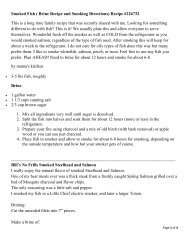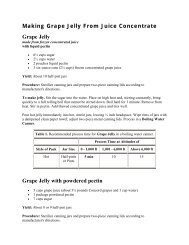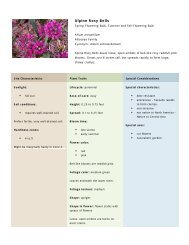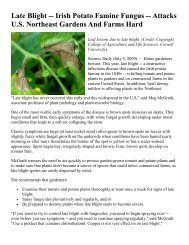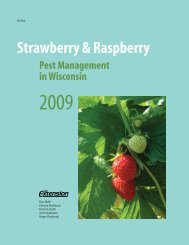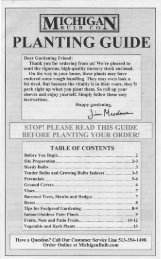Growing Blackberries in Your Home Garden, EC 1303 (Oregon ...
Growing Blackberries in Your Home Garden, EC 1303 (Oregon ...
Growing Blackberries in Your Home Garden, EC 1303 (Oregon ...
- No tags were found...
Create successful ePaper yourself
Turn your PDF publications into a flip-book with our unique Google optimized e-Paper software.
How much should I fertilize?A good guide for fertilization is to observeplant growth. Primocane leaves should be ahealthy green; a pale green or yellow colormay <strong>in</strong>dicate nitrogen deficiency. Canesshould grow well.Care of establishedplant<strong>in</strong>gsFertiliz<strong>in</strong>gAfter the plant<strong>in</strong>g year, apply fertilizer annuallyto ma<strong>in</strong>ta<strong>in</strong> good growth and leaf color.Apply from 1 to 1 1 ⁄2 oz N per plant (6.3 to 9.5 oz16-16-16 per plant) per year. Divide the total <strong>in</strong>tothirds, and apply one-third at each of three times:(1) when the new primocanes start to grow,(2) at the end of May, and (3) at the end of June.Spread fertilizer over the entire surface of the soil<strong>in</strong> the row. Irrigate right after fertiliz<strong>in</strong>g.If you use manure, apply it <strong>in</strong> late fall orearly w<strong>in</strong>ter to a depth of 2 to 3 <strong>in</strong>ches <strong>in</strong> the row.Reduce the rate of nitrogen fertilizer applied byone-half. Manure applied early <strong>in</strong> the fall maycause blackberries to grow late <strong>in</strong> the season, mak<strong>in</strong>gthem more susceptible to w<strong>in</strong>ter <strong>in</strong>jury.If you use organic mulches for weed control,you may need to apply additional nitrogen fertilizerto assist <strong>in</strong> breakdown of the mulch.IrrigationEstablished blackberry plants need 1 to1 1 ⁄2 <strong>in</strong>ches of water per week from mid-Junethrough late summer. Irrigate when ra<strong>in</strong>fall doesn’tprovide this amount. Plants need more water <strong>in</strong>extremely warm and w<strong>in</strong>dy conditions. To avoidexcessive disease to canes or fruit, it is best to usedrip irrigation or under-canopy spr<strong>in</strong>klers.Weed managementCultivate to control weeds. Cultivate no deeperthan 1 to 2 <strong>in</strong>ches to prevent root damage. You canuse a mulch or landscape cloth (weed mat) aroundtrail<strong>in</strong>g and semierect blackberries to controlweeds. Weed mat is not recommended for erecttypes as it will prevent primocane emergence fromroots.Prun<strong>in</strong>g and tra<strong>in</strong><strong>in</strong>gPrun<strong>in</strong>g <strong>in</strong>structions vary by the type ofblackberry.Trail<strong>in</strong>g blackberryTrail<strong>in</strong>g blackberries produce new primocanes<strong>in</strong> the spr<strong>in</strong>g at the crown of the plant. (No rootsuckers are produced.) After grow<strong>in</strong>g upright for ashort time, these canes turn down and grow alongthe ground.After the first year, there will be fruit<strong>in</strong>g caneson the wire, while new primocanes will grow fromthe crown start<strong>in</strong>g <strong>in</strong> spr<strong>in</strong>g. To avoid damage tonew primocanes, keep them tra<strong>in</strong>ed <strong>in</strong> a narrowrow beneath the bear<strong>in</strong>g canes (Figure 1, page 3).If you have more than one plant, tra<strong>in</strong> all theprimocanes <strong>in</strong> one direction down the row (ratherthan what is shown <strong>in</strong> Figure 1). This will helpprevent primocanes from tangl<strong>in</strong>g and make tra<strong>in</strong><strong>in</strong>geasier. Do not summer prune or tip primocanesdur<strong>in</strong>g the grow<strong>in</strong>g season.After fruit harvest, the floricanes start to die.Unless there is a lot of cane disease, it’s best todelay cutt<strong>in</strong>g off the canes as long as possible.This allows the dy<strong>in</strong>g canes to move nutrients back<strong>in</strong>to the crown and roots, mak<strong>in</strong>g for a healthierplant.In western <strong>Oregon</strong>, it’s best to tra<strong>in</strong> the newprimocanes on the trellis <strong>in</strong> late August. The riskof cold <strong>in</strong>jury <strong>in</strong>creases if you wait to tra<strong>in</strong> <strong>in</strong>September through fall. In eastern <strong>Oregon</strong> andWash<strong>in</strong>gton, leave the primocanes on the ground.In areas with frequent low w<strong>in</strong>ter temperatures,you can try to protect the canes through the w<strong>in</strong>terwith a straw mulch. Then tra<strong>in</strong> the primocanesonto the trellis <strong>in</strong> late February, after any danger ofsevere cold has passed. Tra<strong>in</strong><strong>in</strong>g canes dur<strong>in</strong>g coldtemperatures is not advised, as brittle canes breakeasily.5




